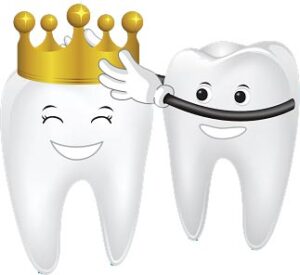
- Address 2148 Ocean Ave, Ste 401A, Brooklyn NY 11229
- Schedule Appointment
- Call Now 718-339-1810

White crowns blend in with the color of your children’s other teeth. They’re used when your kids need a strong covering over a decayed or damaged tooth. White crowns for primary teeth often are provided by your pediatric urgent care dentist in Brooklyn after your kids get injured playing sports. Severe decay that has an impact on future growth of permanent teeth is another reason you may need to call on a children’s emergency dentist to get white crowns for baby teeth.
A child’s primary or baby teeth need to remain in the mouth until the adult tooth underneath is ready to erupt. At this stage, the primary tooth root begins to resorb, so the baby tooth starts to loosen and eventually falls out. It is replaced with the adult tooth shortly after.
 Baby teeth, referred to as primary teeth by your pediatric dentist in Brooklyn, can develop tooth decay and cavities. Actually, tooth decay on primary teeth is more common than reported. Pediatric dentistry of Brooklyn can tell you it also doesn’t happen solely because of neglect.
Baby teeth, referred to as primary teeth by your pediatric dentist in Brooklyn, can develop tooth decay and cavities. Actually, tooth decay on primary teeth is more common than reported. Pediatric dentistry of Brooklyn can tell you it also doesn’t happen solely because of neglect.
Tooth decay requiring white crowns often occurs because of acid-producing bacteria. These bacteria may be transmitted to your baby through your saliva. When you’re doing something as harmless as taste-testing food for spice or temperature, cleaning a pacifier in your mouth or sharing the same spoon or fork, you pass these bacteria to your child.
Dental crowns, also called caps, are fixed prosthetics that get cemented onto a tooth. Crowns cover damaged teeth while improving their overall appearance and alignment. Crowns are formed after an impression is taken by the dentist of the tooth or teeth to be covered by the crown.
Crowns cover damaged, deformed, heavily filled or weakened teeth. Crowns are different from fillings, since crowns are used for more serious instances of teeth damage while fillings are used by your pediatric dentist in Brooklyn for smaller amounts of damage. There are two different types of white crowns:
Dr. Tracy and Dr. Igor provide expert preventive dentistry care for our young patients, helping to ensure primary teeth remain strong and healthy until the adult teeth come through. However, despite this, tooth decay is still a common problem.
Tooth decay is a bacterial infection. The bacteria are most often transmitted from parent to child, or from siblings or other caregivers. Something as simple as sharing utensils with a young child or cleaning a pacifier by licking it will transfer potentially harmful bacteria from your mouth to your child’s. The problem is worsened if you or another caregiver already has dental problems and where your mouth may contain more bacteria than someone with good dental health.
When a tooth develops a cavity, we remove the damaged portion of the tooth and can place a suitable filling material. If a tooth is substantially decayed, we will suggest covering it entirely with a dental crown.
Primary teeth that have received root canal treatment usually need covering with a dental crown since they have most likely lost a large portion of their original structure. Children can sometimes need a crown for a primary tooth if they have a dental accident, resulting in a tooth becoming chipped or cracked, or where they lose a substantial portion of the original tooth.
White crowns are ideal if your child needs a crown for a front tooth that will be highly visible whenever they smile, and especially if it will be a while before their adult tooth comes through. The material is highly biocompatible and will not stain. Ceramic crowns are also very durable, as the porcelain used to make them is very strong. We can generally make and fit a white crown during a single visit to our dental office.
When a back tooth needs a crown, we will fit a stainless steel crown in preference to a white crown. A stainless steel crown is extremely durable and more suitable for restoring a child’s primary back tooth.
Stainless-steel crowns are pre-made from durable stainless steel and are a tried and tested solution for protecting decayed or damaged primary teeth. A stainless-steel crown can be made purely from metal, or it may have a tooth-colored facing made from composite resin to create a more aesthetically pleasing appearance.
A stainless steel crown with a tooth-colored facing is ideal when restoring a front tooth, and provides a good cosmetic appearance. An all stainless steel crown is an economical option for teeth that are less visible in the mouth, such as large molars and where aesthetics is not a major concern.
Stainless steel crowns can also be used as an attachment for space maintainers. We may need to fit a space maintainer when we remove a severely damaged or decayed tooth in the mouth prematurely, and it helps to hold open enough space for the adult tooth to erupt correctly. We can fit a stainless-steel crown during a single visit to our pediatric dental office. Because they are pre-made, we can prepare a tooth and customize and fit the crown relatively quickly, which can be more comfortable for children who already feel a little anxious or apprehensive about their dental visit.
In addition to being more cosmetically appealing than metal crowns made of gold or other alloys, white crowns blend in easily with your child’s teeth. White crowns for primary teeth are fitted using either resin, resin-modified glass ionomer (RMGI) or bioactive RMGI cements. As these crowns are pre-made, one visit is typically all it takes for the procedure’s successful completion. Here’s what happens during your visit:
The benefits of white crowns for baby teeth include:
Even though your children’s primary teeth aren’t permanent, you can’t disregard them. The health of these teeth affects the health of the adult teeth that follow. Typically, by age three, all the primary teeth are fully developed. Avoid the following to maximize your child’s dental health:
When looking for the best children’s dentist, you want one whose focus after preserving the health of your children’s teeth is on empowering you with information to prevent tooth decay. Primary teeth start coming through your children’s gums around six months, and all typically fully develop by the time your child is 2½ years old.
The best pediatric dentist recommends:
When tooth decay has reached a certain point, white crowns may be necessary. Accidents during play or other activities can cause damage requiring white crowns for primary teeth. Your children’s dentist in Brooklyn recommends crowns if your children’s teeth are chipped, misshapen or underdeveloped. White crowns for baby teeth give more correction and protection than a filling can provide for damaged or misshapen teeth.
Do you have any questions about the White Crowns for Primary (Baby) Teeth in Brooklyn? For more information or to schedule an appointment with the Brooklyn best pediatric dentists Igor Khabensky DDS and Dr. Kim DDS of Brooklyn Pediatric Dentistry Center? Please contact our pediatric dentistry center for consultation with the kids dentist.
Pediatric Dentistry Center
2148 Ocean Ave, Ste 401A
Brooklyn, NY 11229
☎ 718-339-1810


